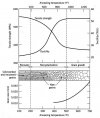My seating force was light but the shoulder was so soft I could dent it with a screw driver.I did it to show unbelievers that salt bath annealing can be done but I went farther by heating salt bath at 850-900 for 10 seconds.That is what ruined the brass that would not hold a primer anymore so I merely used it as a test for 5 cases and all collapsed at the shoulder.
Just wanted to clarify my original post sir as it may have caused more questions than answers.
Just wanted to clarify my original post sir as it may have caused more questions than answers.


